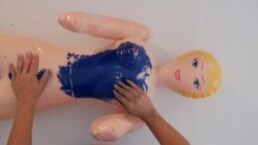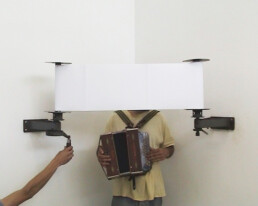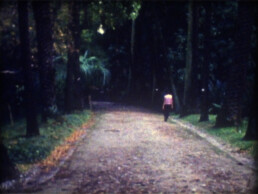VEM 2021 – Agosto
18 de Agosto
¡ÉSTA ES UNA PLAZA! – MADRID19 de Agosto
MUSEO VOSTELL – MALPARTIDA DE CÁCERES20 de Agosto
JARDIM MUNICIPAL DE PAÇO DE ARCOS – OEIRAS21 de Agosto
CENTRO HISTÓRICO DA VILA DE OEIRAS23 e 23 Agosto
CCB – CENTRO CULTURAL BELÉM – LISBOA
Programa
. Mané: Período Azul (2018 /11’45)
. João Cristóvão Leitão: O Retrato de Ulisses (2015 / 5’17)
. João Bento: Aquela velha questão do som e da imagem (2000 / 2’48)
. Eunice Artur & agendas obscuras: Pandopticon (2020 / 13’32)
. Tiago Rosa-Rosso: Zootrópio (2016 /14′)
Período Azul (2018 /11’45) – Mané
A revisitação de obras icónicas de ‘grandes mestres da arte’ (do séc. XX ao presente) por ordem não necessariamente cronológica é centrada na cor azul, ponto de partida para a narrativa que se desenrola (literalmente) sobre um rolo de papel. Este é, sucessivamente, rodado/desenhado/rodado, num movimento mise en abîme que reproduz materialmente o loop imaterial da imagem.
A construção de imagens icónicas (e irónicas) faz-se, inicialmente, a partir das ferramentas tradicionais do desenho/pintura, media que vai sendo substituído por objectos domésticos/íntimos, culminando numa sugestiva masturbação.
O loop reformula o significado das acções e dos objectos convocados. O efeito de espelho entre o loop e o seu reflexo sublinha a repetição (sistemática) de uma tendência (sistémica) nos momentos significativos de transição na arte ocidental, assinalando a constante nas convenções substituídas e substituintes. A página volta sempre a ficar em branco: pronta a ser reescrita.
O Retrato de Ulisses (2015 / 5’17) – João Cristóvão Leitão
O Retrato de Ulisses é uma vertiginosa viagem pelo tempo e pela literatura. Uma viagem onde Ulisses se encontra enclausurado pelo mecanismo que é o loop. Uma viagem que questiona a identidade humana aquando do seu confronto com a possibilidade da circularidade do tempo e com as durações objectiva e subjectiva deste.
Ulisses é Ulisses. No entanto, tal não significa que também não seja Cervantes, Pierre Menard, Alexandre Magno, César, Homero, Tchekov, Nietzsche, Borges e, indubitavelmente, eu próprio.
Aquela velha questão do som e da imagem (2000 / 2’47) – João Bento
Uma paisagem que se move (através das bobines encontradas num cinema velho e devoluto), um observador fixo e uma banda sonora.
Este vídeo corresponde a um período de pesquisa e investigação levado a cabo no final dos anos 90, na qual explorava exaustivamente questões que se relacionavam com a fotografia, o cinema, o vídeo e o som. Questionando assim estes diferentes mas complementares suportes, transformando-os através do uso de outros meios artísticos e preservando o seu modo arcaico de funcionamento através das características próprias de cada um deles. Abrindo desta forma um salto para lá da objectividade que caracteriza a fotografia, onde através de um corpo maior de trabalho daqui derivado explorava o modo como olhamos e reenquadramos mentalmente uma imagem fixa. A fotografia estabelece uma fixação num tempo específico que não se apaga fisicamente em direcção a outro momento. Este apagar apenas ocorre ou pode decorrer no nosso sistema perceptivo. Característica humana contrária à reprodutibilidade sonoramente mecanizada da fotografia. Começou para mim aqui uma grande questão entre o som e a imagem.
Pandopticon (2020 / 13’32) – Eunice Artur & agendas obscuras
liberdade de confinamento,
proximidade à distância,
terraços da janela traseira,
poluição da natureza,
movimento de quietude,
vizinhos estranhos,
aptidão para doenças,
intermediário do quotidiano,
Março Abril,
praga ano 20 20.
panóptico pandémico.
Zootrópio (2016 /14′) – Tiago Rosa-Rosso
Zootrópio é um brinquedo óptico da era pré-cinema. Consiste num cilindro com sucessivas janelas dispostas verticalmente. Na área da superfície interior do cilindro é colocado um conjunto de imagens em sequência. Ao girar o usuário vê uma rápida sucessão de imagens que produzem a ilusão de movimento.
VEM 2021 – August
18 August
¡ÉSTA ES UNA PLAZA! – MADRID19 August
MUSEO VOSTELL – MALPARTIDA DE CÁCERES20 August
JARDIM MUNICIPAL DE PAÇO DE ARCOS – OEIRAS21 August
CENTRO HISTÓRICO DA VILA DE OEIRAS23 and 23 August
CCB – CENTRO CULTURAL BELÉM – LISBOA
Programme
. Mané: Período Azul (2018 /11’45)
. João Cristóvão Leitão: O Retrato de Ulisses (2015 / 5’17)
. João Bento: Aquela velha questão do som e da imagem (2000 / 2’48)
. Eunice Artur & agendas obscuras: Pandopticon (2020 / 13’32)
. Tiago Rosa-Rosso: Zootrópio (2016 /14′)
Período Azul (2018 /11’45) – Mané
A non-chronological revisiting of iconic works of ‘the great masters of art’ (from the 20th century to the present) centered on the blue color as a starting point for the narrative that (literally) unfolds on a roll of paper. It is successively rotated/drawn/rotated, in a mise en abîme movement that materially reproduces the immaterial loop of the image. The construction of iconic (and ironic) images is initially done by using the traditional tools of drawing and painting, later replaced by domestic/ intimate objects, culminating in a suggestive masturbation. The loop reshapes the meaning of the actions and objects. The mirror effect between the loop and its reflection underlines the (systematic) repetition of a (systemic) tendency at significant moments of transition in Western art, signaling the constant in the replacing and substituted conventions. The page returns always as a blank one: ready to be rewritten.
O Retrato de Ulisses (2015 / 5’17) – João Cristóvão Leitão
“Ulysses’ Portrait” is a giddy journey through time and through literature. A journey where Ulysses is entrapped by the mechanism that is the loop, which operates at a narrative level, at a spatio-temporal level (given the use of a single sequence shot) and at a visual level (by means of the constant reuse of the same imagery material).
After all, “Ulysses’ Portrait” is nothing more than an act of questioning human identity when confronting it with the possibility of time’s circularity and with its objective and subjective durations. Ulysses is Ulysses. However, that doesn’t mean that he isn’t, simultaneously, Cervantes, Pierre Menard, Alexander the Great, Caesar, Homer, Tchekhov, Nietzsche, Borges and, undoubtedly, myself as well.
That old question about sound and image (2000 / 2’47) – João Bento
A landscape that moves (through the reels found in an old and empty movie theatre), a static observer and a soundtrack. This video corresponds to a period of research carried out in the late 1990s, in which I exhaustively explored some issues related with photography, film, video and sound. Questioning these different but complementary supports, transforming them through the use of other artistic practices and preserving their archaic way of functioning through their own intrinsic characteristics. In this way, we got beyond the objectivity that characterizes photography, by a larger body of work which derived from it, I explored the way we look and mentally re-establish a static image. Photography establishes a fixation at a specific time that does not physically erase itself while moving into another moment. This erasing only occurs or may occur in our perceptual system. A human characteristic contradictory to the sonorously mechanized reproducibility of photography. Between sound and image, this became a great question to me
Pandopticon (2020 / 13’32) – Eunice Artur & agendas obscuras
Confinement freedom,
distance proximity,
rear window terraces,
nature pollution,
stillness movement,
strangers neighbors,
disease fitness,
quotidian intermission,
march april,
20 20 year plague.
pandemic panopticon.
Zootrópio (2016 /14′) – Tiago Rosa-Rosso
A zoetrope is a pre-film animation device. It consists of a cylinder with slits cut vertically in the sides. On the inner surface of the cylinder is a band with images from a set of sequenced pictures. By turning it, the user sees a rapid succession of images, producing the illusion of motion.





